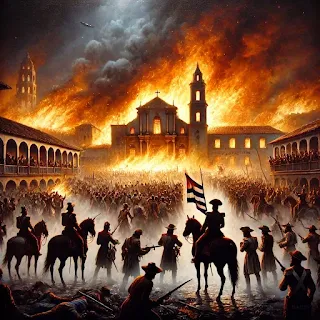The burning of Bayamo (often misspelled as "Ballamo") is one of the most dramatic and symbolic moments in Cuba’s fight for independence. It took place during the Ten Years’ War (1868-1878), the first of three major wars fought by Cuban insurgents, known as Mambises, against Spanish colonial rule.
Historical Background
The Ten Years' War began in October 1868 when Carlos Manuel de Céspedes, a wealthy landowner, declared Cuba's independence from Spain in his famous Grito de Yara (Cry of Yara). Céspedes freed his slaves and called on others to join the struggle for independence. The uprising quickly gained momentum, and the Mambises (Cuban guerrilla fighters) began to organize.
Bayamo, a city located in the eastern part of Cuba, became a focal point of the Cuban rebellion. Bayamo was one of the first cities to support the insurgents and declare its independence from Spain. The city's residents were deeply committed to the cause, and Bayamo played a key role in the early stages of the war.
The Burning of Bayamo (1869)
In October 1868, shortly after Céspedes' declaration of independence, the Mambises captured Bayamo from Spanish forces. For several months, Bayamo became the heart of the Cuban independence movement, and it was here that the Cuban national anthem, La Bayamesa, was written and first sung.
However, the Spanish forces soon regrouped and mounted an offensive to retake the city. In January 1869, as the Spanish army approached, the Mambises and the people of Bayamo faced a difficult decision. Rather than surrender the city back to Spanish control, the leaders of the independence movement made a fateful choice: they would burn Bayamo to the ground.
On January 12, 1869, as Spanish forces closed in, the citizens of Bayamo set fire to their homes, businesses, and public buildings. The flames consumed the entire city, reducing it to ashes. This act of defiance was a powerful statement of the Cuban people's determination to win their freedom, even at the cost of their own homes and possessions.
Why Did They Burn Bayamo?
The decision to burn Bayamo was driven by several factors:
Defiance and Resistance: The people of Bayamo did not want the Spanish to reclaim the city and use it as a base of operations to continue oppressing the Cuban people. By burning their city, they denied the Spanish forces any resources or strategic advantage.
Symbol of Sacrifice for Freedom: The burning of Bayamo became a symbol of the ultimate sacrifice for independence. It demonstrated that the Cuban people were willing to destroy their own homes and livelihoods rather than live under Spanish rule. This act of sacrifice inspired other cities and regions to continue fighting for Cuban independence.
Strategic Advantage: From a military standpoint, the destruction of Bayamo also denied the Spanish army access to vital supplies, food, and shelter. The insurgents used guerrilla tactics and often preferred to fight in the countryside, where they knew the terrain better than the Spanish soldiers.
Impact and Legacy
The burning of Bayamo had a significant emotional and psychological impact on the Cuban independence movement. The sight of an entire city being sacrificed in the name of freedom galvanized support for the cause, both within Cuba and abroad. It became a symbol of the Cuban people's unwavering commitment to liberty.
Although Bayamo was destroyed, its importance in the struggle for independence only grew. The people of Bayamo are remembered for their bravery and sacrifice, and the city itself was later rebuilt. Today, Bayamo is known as the "Cradle of Cuban Nationality" because of its role in the early stages of the independence movement.
The Role of the Mambises
The Mambises were key to the decision to burn Bayamo. These guerrilla fighters, many of whom were former slaves, were the backbone of the Cuban independence movement. Their tactics, which included hit-and-run attacks and scorched-earth strategies like the burning of Bayamo, allowed them to resist Spanish forces for years despite being outnumbered and outgunned.
The burning of Bayamo also reflects the spirit of the Mambises: their willingness to make personal sacrifices for the greater cause of independence. This spirit would continue to define the Cuban fight for independence throughout the Ten Years' War, the Little War (1879-1880), and the War of Independence (1895-1898).
Conclusion
The burning of Bayamo in 1869 was a defining moment in Cuba’s struggle for independence. It symbolized the Cuban people's refusal to submit to colonial rule and their willingness to make great sacrifices for freedom. The Mambises, along with the citizens of Bayamo, showed the world that they were prepared to fight to the end for their right to self-determination, even if it meant destroying their own city to deny the enemy a victory.
Bayamo’s legacy as the birthplace of Cuban nationalism and its role in the independence movement remains a source of pride for the Cuban people to this day. Would you like to know more about the Mambises or other key events in Cuba’s fight for independence?


No comments:
Post a Comment
Note: Only a member of this blog may post a comment.